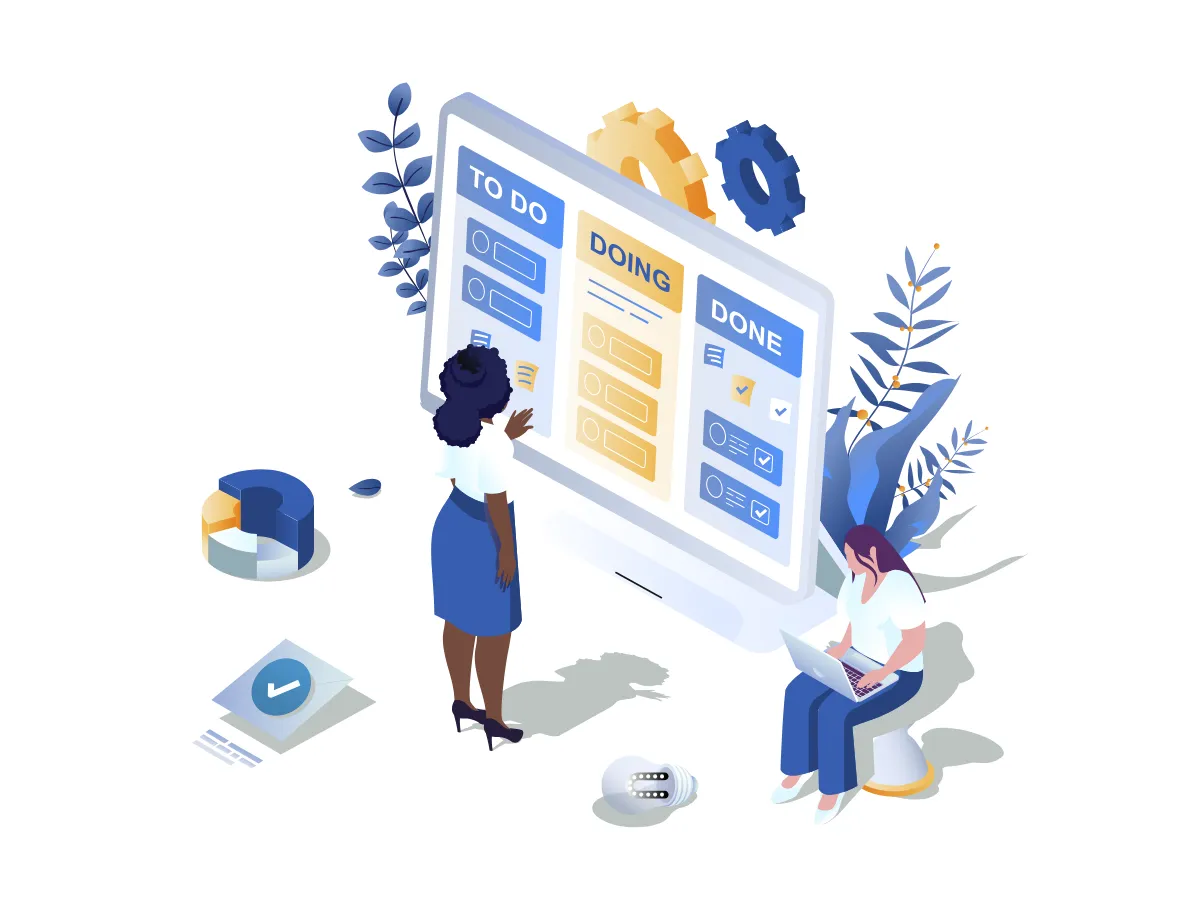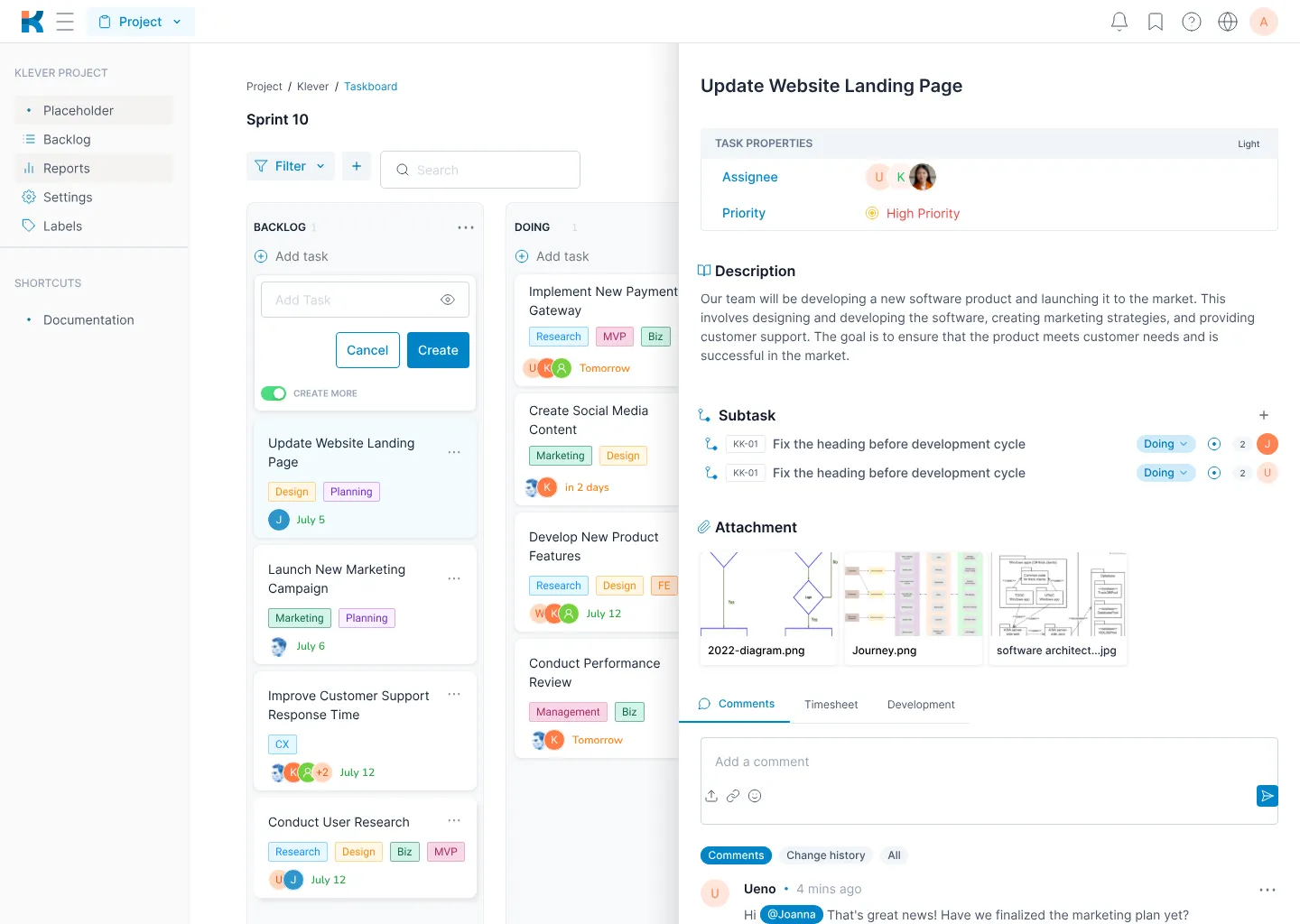Scrum vs Kanban: Differences & Which Is Best For You?
Scrum and Kanban are two popular Agile project management methods, but it's important to understand the differences to help you decide. Learn more!


In Agile, teams can choose between two project management methodologies to collaborate and accomplish project success: Scrum or Kanban. Both rely on iterative approaches to product delivery, prioritizing speed, agility and the ability to make constant iterations rather than follow a linear path.
Despite sharing an overarching agile philosophy, Kanban and Scrum have many practical differences. You may have seen leaders champion scrum while others promote the merits of using Kanban–so how do you decide which is truly right for you?
In this article, we’ll explore:
- What is Scrum?
- What is Kanban?
- What are the differences between Scrum and Kanban?
- When to use Scrum or Kanban?
By the end of this article, you should have a better idea of Scrum and Kanban and which to use for you and your teams!
Let’s get started!
What is Scrum?
Scrum is an agile project management framework focusing on iterative task completion to accomplish the team's goals. Because of this, Scrum is perfect for facilitating collaboration and teamwork on more complex projects.
In Scrum, teams collaborate in a given set of periods, otherwise known as sprints. Teams will work on a list of deliverables and try to complete them at the end of each sprint.

Let’s break it down further:
What’s the timeline like in Scrum?
Scrum tackles a prioritized list of deliverables in a series of sprints (periods of time that can last for a week, two weeks, or even a month). Teams will first hold a sprint planning meeting, discussing which deliverables are prioritized and feasible to be delivered at the end of a sprint. Once development begins, the team will hold daily stand-up meetings to touch base with each other and ensure everyone can meet the sprint targets. Once the sprint has been completed, the team will hold a sprint review meeting, allowing team members to discuss their deliverables and present their work for feedback or approval. Sprint retrospective meetings at the end of the sprint are also held to discuss the lessons learned and the great things that happened in the current sprint before moving on to the next sprint planning session.
How often do you release your deliverables?
Deliverables are released at the end of each sprint. After the sprint is reviewed, tasks that are not complete will be analyzed and added to the next sprint (or moved back to the backlog).
Are there any roles in Scrum?
Scrum has unique roles that only exist in it, including the Scrum master and product owner. The Scrum master focuses on the team and its operations. They often help manage the team’s motivation and efficiency to ensure the project's timely completion. A product owner is someone responsible for focusing on the product. They manage the backlog (a list of tasks placed on hold that have not yet been worked on) and determine product requirements and priorities. The team or team members are the development team who do the work assigned within the Scrum sprints.
What are the most critical metrics in Scrum?
Some metrics used in Scrum include team velocity, sprint burndown, effort estimation variance, scope change, defect leakage, and more.
How often does change happen in Scrum?
Changes and adaptations can be addressed at the end of each sprint. During the sprint retrospective meeting, any changes or improvements that need to be implemented can be noted and introduced to the next sprint. Changes in new work items cannot be made until after a sprint ends.
Klever Project features a customizable Kanban board with a Backlog feature only available in Scrum, making it easy to start any project!

What is Kanban?
Like Scrum, Kanban is a framework for agile project management. Kanban is a continuous workflow that emphasizes real-time communication and transparency of work. All work items are visually represented on a Kanban board consisting of cards that indicate flow from one another–one of the most important artifacts in the kanban framework.
Kanban board helps teams visualize their tasks and progress to maximize productivity and efficiency. Each column can represent a project stage or status and is easily customized to individual or project needs.

What’s the timeline like in Kanban?
Each column in a Kanban board represents each workflow stage in completing your action items. The most common stages in a kanban board includes: To Do, In Progress, In Review, Blocked, and Done. You can move around action items to a column, depending on its status: is it in progress or review? With Kanban, you can easily customize your project or team’s needs and visualize the tasks in each workflow stage.
How often do you release your deliverables?
With Kanban, deliverables are released when ready, not necessarily restricted to a due date or a set schedule. If a deliverable is completed early, it can be released early or even late, depending on the team’s needs.
Are there any roles in Kanban?
Kanban have no predefined roles, although most teams often have a project manager. Additionally, everyone on the team can access a kanban board. Meanwhile, individual members can also have their own Kanban board to break things further if needed. Because kanban doesn’t define roles, it encourages collaboration and collective ownership over tasks.
What are the most important metrics?
Common Kanban metrics include lead time, and cycle time. Other cumulative metrics can be used to see the number of items in each state to uncover bottlenecks.
How often does change happen in Kanban?
In Kanban, change can happen at any time. Cards can get removed or blocked based on priorities. This offers great flexibility and opportunities for change.
Most teams that adopt the Kanban methodology use a digital Kanban board that is shareable across the team to efficiently manage team tasks and be in the loop for task progress and nearing deadlines.
Klever Project features a customizable Kanban board that makes it easy to start any project.

What are the differences between Scrum and Kanban?
Now that we have a better idea of both frameworks, what are the core differences between the two?
There are several differences between Scrum and Kanban, particularly in the work timeline, responses to change, measuring success, and even team roles.
Here’s a rough outline of the two below:
Agile methodology: | Scrum | Kanban |
Roles & responsibilities: | Team members have predefined roles. There’s a Scrum master who dictates the timeline and a product owner who defines the goals. and which team members execute the work | In Kanban, there are no predefined roles for everyone on the team. It’s common for the team to have a project manager, but everyone is encouraged to collaborate and contribute |
Artifacts: | In Scrum, the artifacts includes a product backlog and sprint backlog. These artifacts provide transparency for the expected deliverables, requirements, and implementation | Kanban board is the most important artifact in Kanban, which provides transparency on what is being worked on across all workflow stages |
Delivery timeline: | Deliverables are determined by sprints or set periods where a set of work items must be completed | No pre-defined timeline; products are delivered continuously on an as-needed basis. Some deliverables can be delivered earlier if needed |
Task delegation and prioritization: | Team members will take on tasks in each sprint, but they can only take on new tasks if the previous task is complete | Team members can prioritize and work on other tasks after completing their previous task |
Metrics: | Scrum teams use several data points to improve efficiency and are set during the planning phase to measure progress during standup meetings. Some of the standard metrics are sprint velocity, sprint burndown chart, and more | Two metrics often used in Kanban are cycle time, the amount of time it takes for a task to be completed from start to finish, and lead time, the time between when the action item is requested until its delivery |
Changes: | Changes that happen in the middle of the sprint are not recommended | Changes can be made anytime, allowing for iterations and improvements to be made to the final deliverables before completion |
Applications: | Ideal for teams that need a structured project management framework with stable priorities that do not change over a period of time | Ideal for teams that need a flexible and adaptable project management methodology with widely varying priorities |
Stakeholders/customers: | Scrum includes stakeholder and customer involvement. You can include their involvement at least once a sprint during a sprint review event | Kanban doesn’t provide a way to engage stakeholders or customers. Most teams adopt a once-a-month review as needed |
When to use Scrum or Kanban?
Now that you have a better idea of the practical differences between Kanban and Scrum, how do you decide between them? It depends! The best methodology for you and your teams, will depend on your needs and requirements.
Before deciding, consider two factors when choosing between Scrum or Kanban:
What is the type of work that you do?
It’s essential to determine what type of work you are doing before deciding between Kanban or Scrum. Is the flow of your work or project more predictable? Could some changes or iterations need to be made in the middle of your project? Does your project or team require a more flexible or structured approach to managing the work?
Scrum methodology may suit you best if you’re working on a complex, iterative project such as a new feature development or product. Scrum is also great for projects that typically require members to take up new work only after completing all the work. Meanwhile, Kanban can be great for a continuous flow of work and is working on one thing after another. Kanban can also help address small work, including bug fixes, small enhancement requests made to a website, and customer support tickets.
How familiar is your team with Kanban and Scrum?
Using Kanban or Scrum can depend on your team’s experience and expertise with the two project management frameworks. How familiar is your team with Scrum? Does your team have members who can focus on the roles and responsibilities of a product owner or a Scrum master? If so, it may be great to use Scrum. If your team members are working on multiple tasks with varying expertise, it may be fitting to use Kanban.
Klever Suite for all your project management needs
If you’re looking for a collaboration tool that makes it easy for teams to manage all kinds of projects, whether using Kanban or Scrum–look no further than Klever Suite!
Klever Suite is an integrated workspace where teams of any size can simultaneously manage their tasks, Wiki docs, and projects. Manage all kinds of projects, whether it’s Kanban or Scrum, with ease, thanks to our customizable Kanban board in Klever Project. Achieve clarity on your project and team performance with Klever Project's comprehensive reports.
Unlock the power of Klever Suite today for free. Experience Klever Suite's robust features and see the magic for yourself!
About the author
Klever Suite Marketing Team
マーケティング担当者
Other articles
Don't miss out on the latest tech trends and beyond with our insightful articles.
See all our articles
13 Collaboration Tools That'll Make Your Life Easier in 2024
Looking for the right collaboration tool? Check out our guide for the best productivity tools that'll boost your team's productivity in 2024!

Tokyo Techies unveils new version of “Klever Suite”
Klever Suite makes team-wide collaboration a seamless experience for everyone. Learn more about our new features and pricing options now.
One workspace to accomplish all your goals
Get more out of Klever Suite with our 3 months free trial
*No credit card needed for sign ups.
